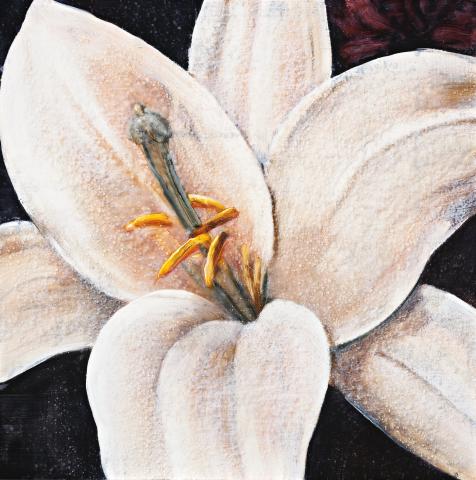UNTITLED 98U36, 1998
TIM MAGUIRE
oil on canvas
119.5 x 119.5 cm
signed, dated and inscribed verso: Maguire' 98 / Untitled 98U36
Mori Gallery, Sydney
Private collection, Sydney
Deutscher-Menzies, Melbourne, 13 September 2006, lot 12
Private collection, Melbourne
© courtesy of Tim Maguire
Tim Maguire is represented by Martin Browne Contemporary, Sydney and Tolarno Galleries, Melbourne
Throughout his career Tim Maguire has explored the notions of reproduction and reality. His 1987 exhibition, The Nature of Things, at Sydney’s Mori Gallery was a series of pastel drawings of mundane everyday objects; an egg, a tea cup, a tin bucket to name a few. Each work was drawn ‘life size’ and stepped up in scale as the series progressed. A drawing of a large tea chest completed the series.
Each of these subjects was depicted on a black reflective ground which caused their reflections to dissolve into the ground. This series signalled Maguire’s enduring curiosity with images where reality gives way to illusion. An artist’s desire to make a subject look real is nothing new, however by reworking details from realist Dutch paintings and abstracting them through magnification, Maguire subverts the painting process and the role of the artist, while exploring a zone where the real becomes imagined.
Maguire’s early paintings drew on Russell Drysdale’s depictions of the outback and amplified key details from Drysdale’s paintings of the Australian landscape. In Maguire’s hands, these images became even more tinged with irony and pathos. His images of water tanks in flood re-awoke Drysdale’s images of discarded and rusted corrugated iron and raised them into a contemporary context. As his work developed, his focus broadened and he began making paintings based on isolated details of seventeenth century Flemish flower paintings.
Here the artist is talking to Jonathan Watkins about his process.... 'Taking a small detail of a reproduction of a still life painting, usually Dutch or Flemish, I’d crop it – I can’t see anything then but the little bit I want, about two percent of the whole picture. The reproductions are often postcard size so the actual dimensions of the detail might be as small as one centimetre squared. This image is then sketched up for the finished work, magnified hundreds of times.........This degeneration is very important to me. It’s another step in the breakdown that occurs as the three dimensional world is translated in to two dimensions. Each step involves a flattening of the image. Originally someone else painted the flowers, probably from a preliminary sketch. The painting was photographed at some time, the photograph was reproduced, published, and then I start to work on it.' 1
Add to this his growing interest in lithography and use of transparent inks, the mechanics of colour soon gained equal importance to the actual subject matter of Maguire’s paintings. This merger allowed the artist to create the glowing, colourful flower paintings for which he is most known. Today, Maguire’s signature works are without doubt his Dutch flower paintings. They represent an artist's probing search for subject, and then having found it, presents paintings of bold, technical virtuosity and beauty.
1. Watkins, J., What is it ‘as it really is’, in Murray Cree, L., (ed.), Tim Maguire, Piper Press, Sydney, 2007, p. 72
HENRY MULHOLLAND
